Archives
As science research and my own knowledge and artistic ability have progressed, I've removed many drawings from this gallery. Rather than let them fester on a hard drive somewhere or in buried piles of sketchbooks, I thought I'd turn them into a public service by critiquing the inaccuracies in my own past drawings.
Avimimus portentosus (Stem-Aves, Caenagnathiformes):
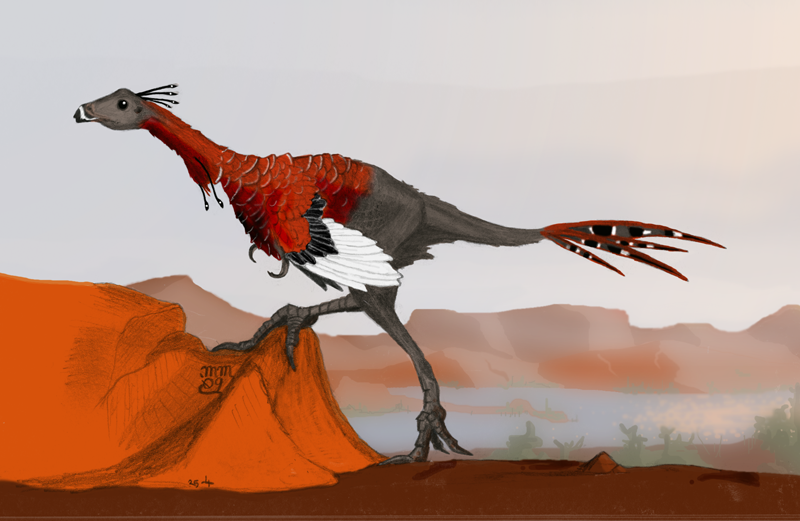
Inaccurate drawing from April 2009. Several quirky inaccuracies with this attempt to illustrate a scene from the Nemegt formation featuring an avimimid. First, the feet ended up extremely large. Looking back through the sources I used, I'm not sure why I illustrated them that way, other than to imply a wading lifestyle. The featherless posterior half of the body is a bit early Greg Paul-ish and very unlikely. You can see a more reasonable Avimimus restoration here.
Family Oviraptoridae (Stem-Aves, Caenagnathiformes):
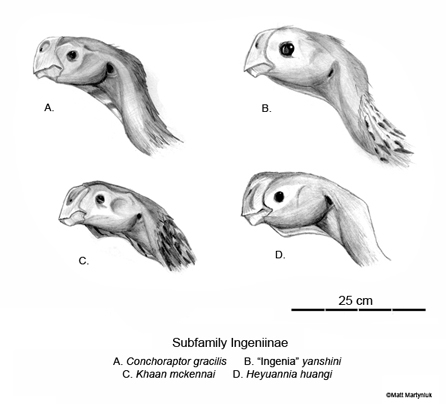
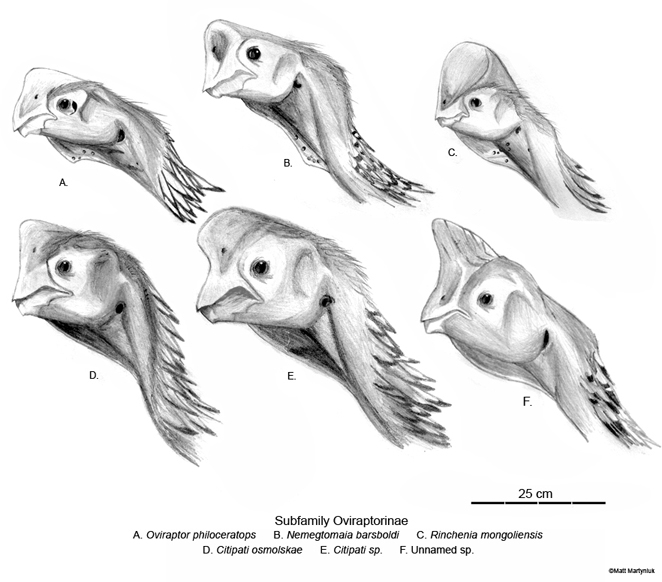
Inaccurate drawings from August 2006. This was my attempt to illustrate the subtle differences between the skulls of various oviraptorids and see how they would translate into life appearance. Unfortunately, one thing I didn't think about much was the morphology of the beak. Thanks to some discussions on DinoForum and later reading Jansen's 2008 thesis on the topic, it's clear that the beaks in this attempt are wrong. While it's possible that they were as extensive as shown, incorporating much of the 'snout' and crest in addition to the usual jaw tips, they also would likely have been flush, upper and lower edges meeting smoothly, not overlapping. I also should have done a better job delineating the beak from the adjoining soft tissue--right now, it looks like the beak encloses the corners of their mouths, rendering the jaw hingeless and unable to open.
Scansoriopteryx heilmanni (Stem-Aves, Scansoriopterygidae):
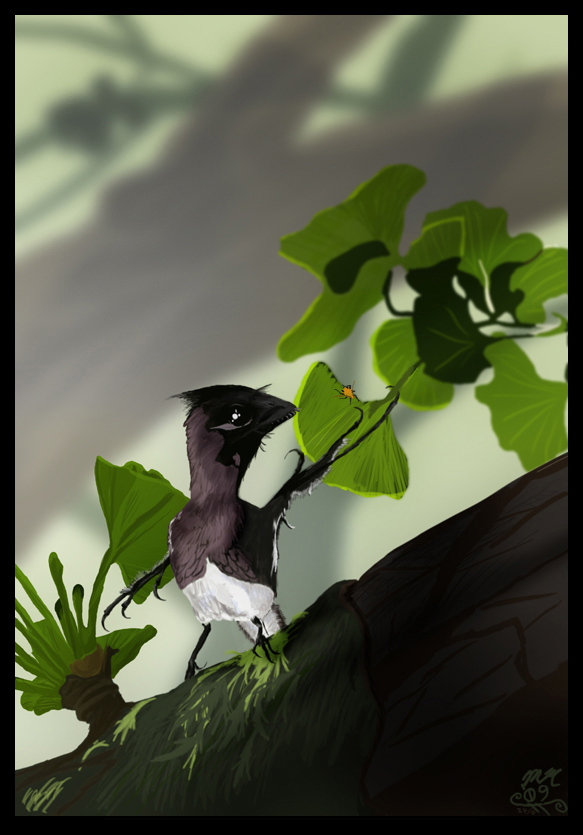
Inaccurate drawing from 23-Apr-2006. The issues surrounding this painting hinge both on inaccuracy and taxonomy. When I painted "Upon Branch", I was following a few online arguments that kept Scansoriopteryx and Epidendrosaurus as separate genera, this one being Epidendrosaurus. But I failed to separate out all the supposed differences between the two. It is now almost universally recognized that these two are the same animal, and with further research I convinced myself that the arguments I'd followed were flawed. I hedged my bets on the tail here (Epi's was long, while Scansor's was supposedly short), but the long rectrices stemming from near the tail base are wrong any way you slice it--like many other early avialans, Scansoriopteryx appears to have had a long, bony tail tipped with a frond of feathers closer to the tip. Also, while the Epi fossil didn't preserve any wing feathers, the Scansor one seems to have them. The skull is poorly preserved in both, but the discovery of close relative Epidexipteryx showed that I got this wrong too; the skull should be tall and box-like, with large forward-pointing teeth, not narrow-snouted and bird-like.
Amphicoelis fragillimus (Stem-Aves, Pachypodosauria):
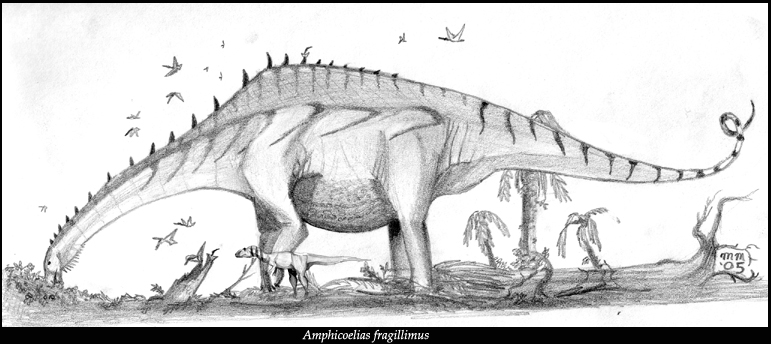
Inaccurate drawing from December 2005. Second of several attempts to restore the mythical gigapod. While the quality has improved since my 2001 rendition, this commits most of the same sins of sauropod restoration, including too many forefoot claws and attendant flock of tiny pteorsaurs (Wyomingopteryx), while sadly losing the double dewlap. Amphi has acclimated to the presence of that little allosaur. This reconstruction is quirky in that it was based on the proportions of dicraaeosaurids rather than diplodocids as usual, and while not technically inaccurate as we have no clue what this thing really looked like, I think the overall body plan here is unlikely.
Sinopterus dongi (Stem-Aves, Pterosauromorpha):
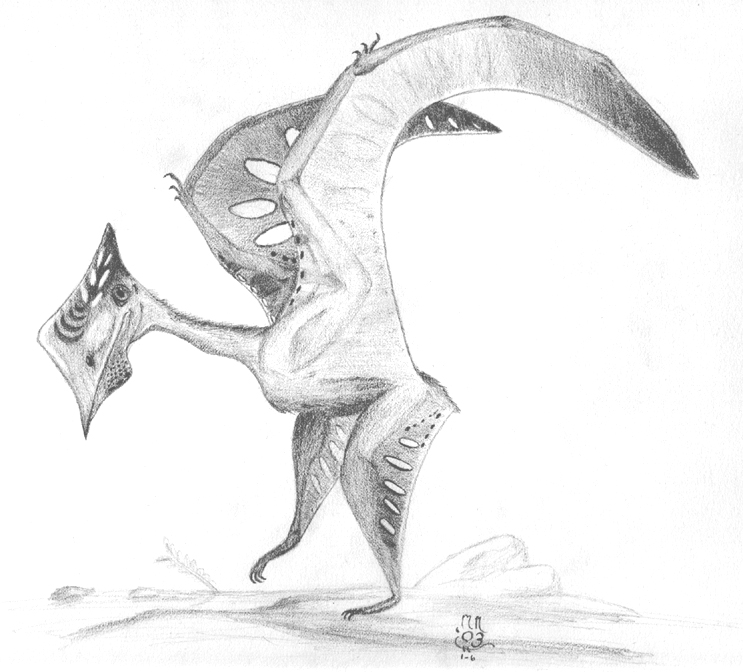
Inaccurate drawing from 1-June-2003. The main inaccuracy in this graphite Sinopterus illustration is the wing attachment. While the exact point of attachment is still controversial, almost everyone agrees that it should be somewhere on the leg, rather than at the hip or torso. There's evidence that in azhdarchids, the wing was broad and attached at or near the ankle. Since tapejarids like this are pretty closely related to azhdarchids, in an updated Sinopterus drawing I would probably choose an ankle attachment and much broader wing chord.
Nyctosaurus sp. (Stem-Aves, Pterosauromorpha):
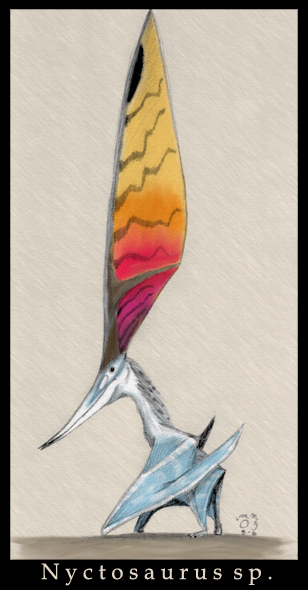
Inaccurate drawing from 6-May-2003. A drawing of one of the most outlandish looking pterosaurs fails to be outlandish enough. The 'sail' I depicted stretching between the otherwise antler-like crests of Nyctosaurus had no basis in fact. Many pterosaurs with huge bony projections on their skulls, specifically the tapejarids, tend to have large, sail-like, soft tissue extensions of weight-saving soft tissue. The transition point between bone and soft tissue is usually obvious, and not present in Nyctosaurus, so it almost certainly was a bare antler-like crest. Studies of potential 'wind-surf skimming' by these pterosaurs also showed that such a sail would do more to hinder feeding over open ocean than help, or at least add no benefit. Also, a second specimen shows that the backward-pointing antler was almost as long as the vertical one, forming an unwieldy-looking fork larger than the animal's entire body. Pterosaurs are weird.
Tupandactylus imperator (Stem-Aves, Pterosauromorpha):
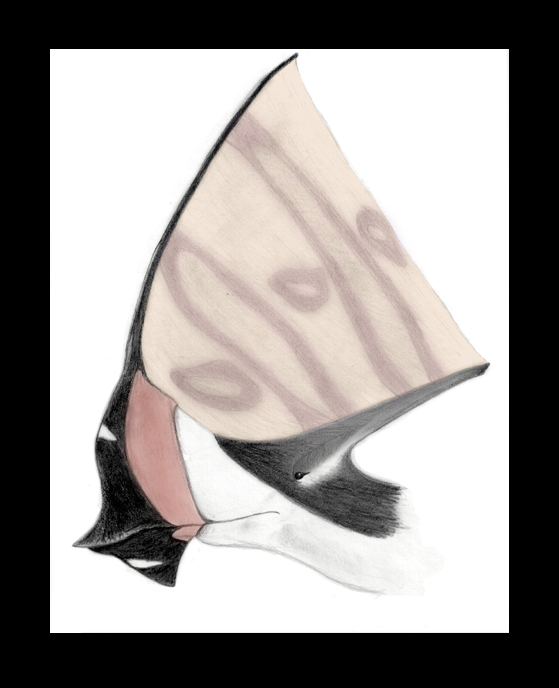
Inaccurate drawing from 2003. Another giant-crested pterosaur, also with an inaccurate soft-tissue crest. This one is less egregious than Nyctosaurus, because here the bony spars did in fact support a large, light extension. However, like some other artists I mistook this for a skin-membrane sail, when it actually was made of hardened fibers and blended seamlessly into the bone, with no taught, skin-like connection at the prong tips. Rather, the back of the crest was probably rounded like in the related Tupandactylus navigans.
Cryptovolans pauli (Stem-Aves, Microraptoria):
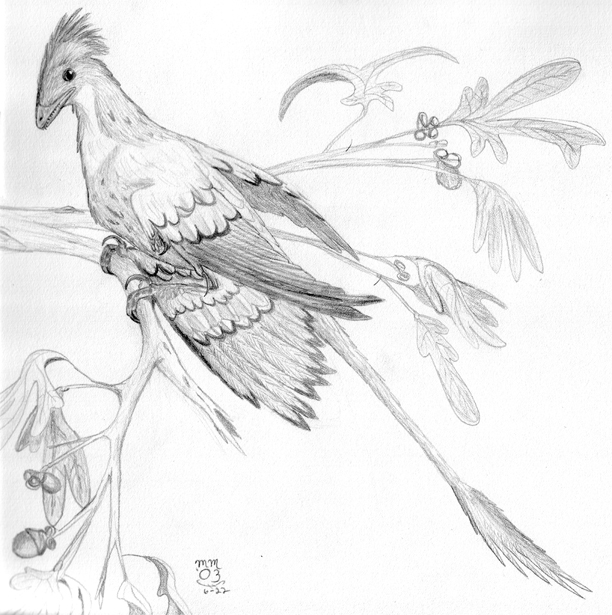
Inaccurate drawing from 22 June 2003. After many misinterpretations (see below), I finally arrived at a generally realistic depiction of a microraptorian (this one based on the type specimen of Microraptor gui). The feather arrangement shown here is generally correct given modern data, but the supposed crest of feathers is probably an artifact of preservation, and the foot anatomy would not have allowed opposability, so perching on such a narrow branch would not have been possible. The tail frond is also far too small.
Citipati sp. (Stem-Aves, Caenagnathiformes):
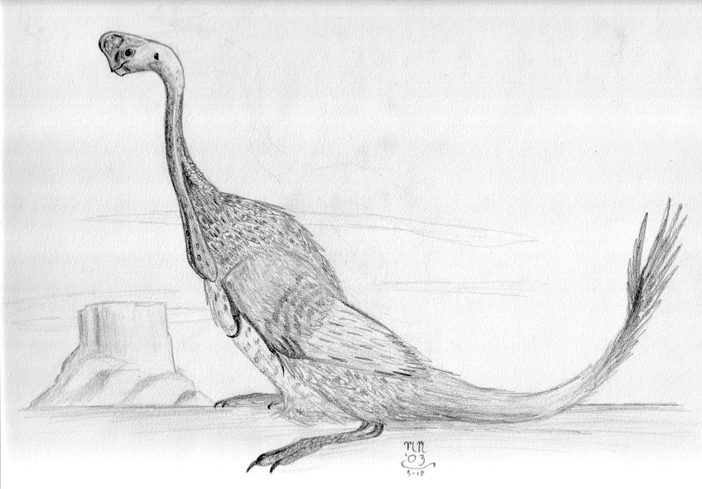
Inaccurate drawing from May 2003. A descent enough drawing of the unnamed Zamyn Khont oviraptorid, though the wing arrangement is a little contorted, the casque weirdly hollowed-out, and the head far too small relative to the body.
Azhdarcho lancicollis (Stem-Aves, Pterosauromorpha):
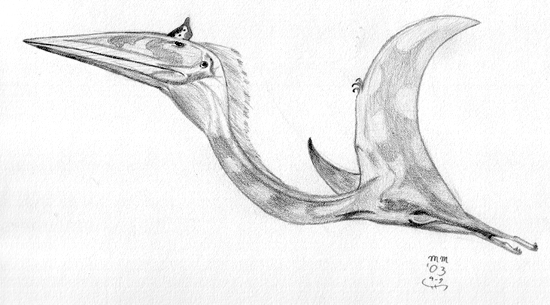
Inaccurate drawing from 9 April 2003. This third attempt to illustrate the namesake of azhdarcho.com is considerably better than the freakish early attempts (see below), with a more proper leg-attaching wing membrane and simplified beak free of weird adornments, but I was sticking to my guns when it came to that gargantuan head and little tiny wings.
Alioramus remotus (Stem-Aves, Coeluria):
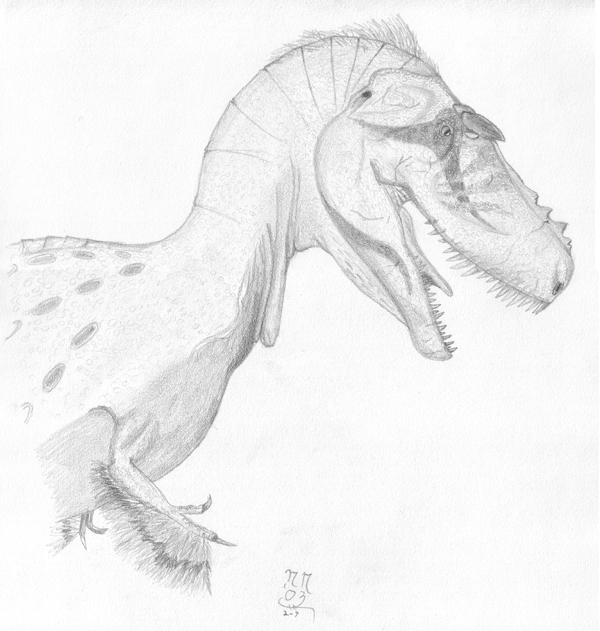
Inaccurate drawing from 7-Feb-2003. A strange deinodontid, Alioramus remotus is known only from a partial skull, the top-front of which is missing. Many early reconstructions gave it a narrow, longirostrine snout. I decided to buck the trend and reconstruct it with a more boxy snout like those of its close relatives Tyrannosaurus and Albertosaurus, with speculative lacrimal horns similar to those of Gorgosaurus sternbergi (the distinct spiky ridge running along the snout was always a known feature). However, later discoveries of the related species Alioramus altai proved the long-snouted versions correct, so this drawing was tossed in the bin.
Cryptovolans pauli (Stem-Aves, Microraptoria):
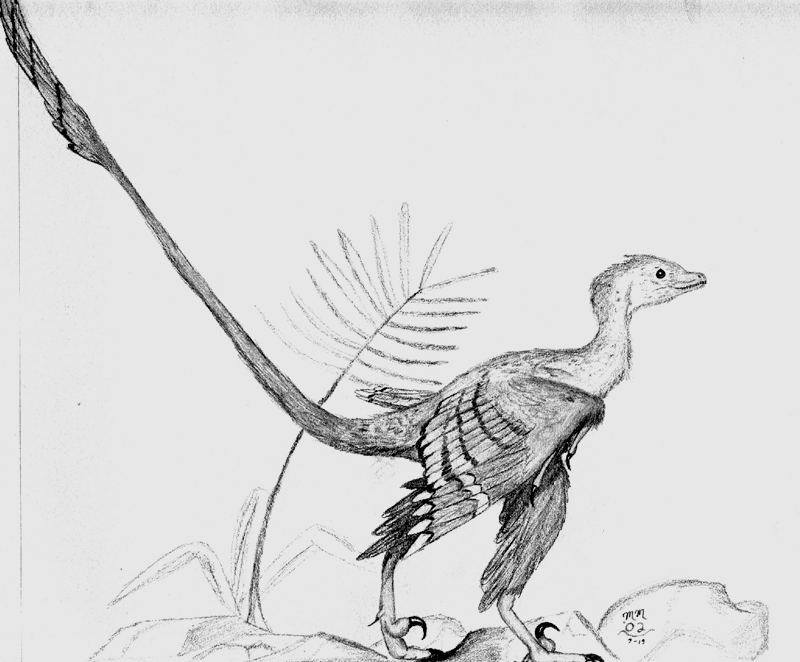
Inaccurate drawing from 19 September 2002. Based on the newly released Czerkas volume, which argued strongly that the supposed "butt fans" (see first restoration of Cryptovolans, below) of the original (then-unnamed) specimen were simply extensions of very long forewing feathers. This interpretation was quickly proved spectacularly wrong by a second specimen referred to the likely synonymous Microraptor gui.
Scansoriopteryx heilmanni (Stem-Aves, Scansoriopterygidae):
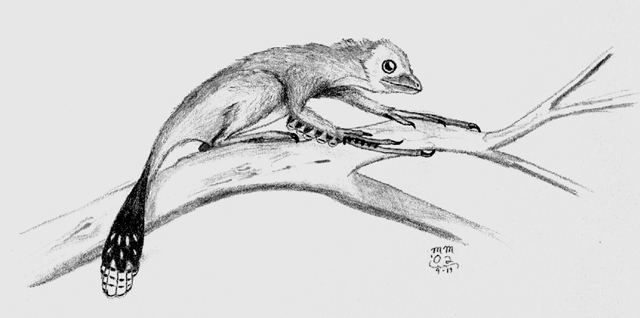
Inaccurate drawing from 19 September 2002. This second drawing based on the Czerkas volume depicts a scansoriopter based on the holotype specimen, with a short tail. As discussed above, it should incorporate more details from Epidendrosaurus. This was my first-ever published drawing, used on the cover of a Canadian paleontology newsletter.
Caudipteryx zhoui (Stem-Aves, Caenagnathiformes):
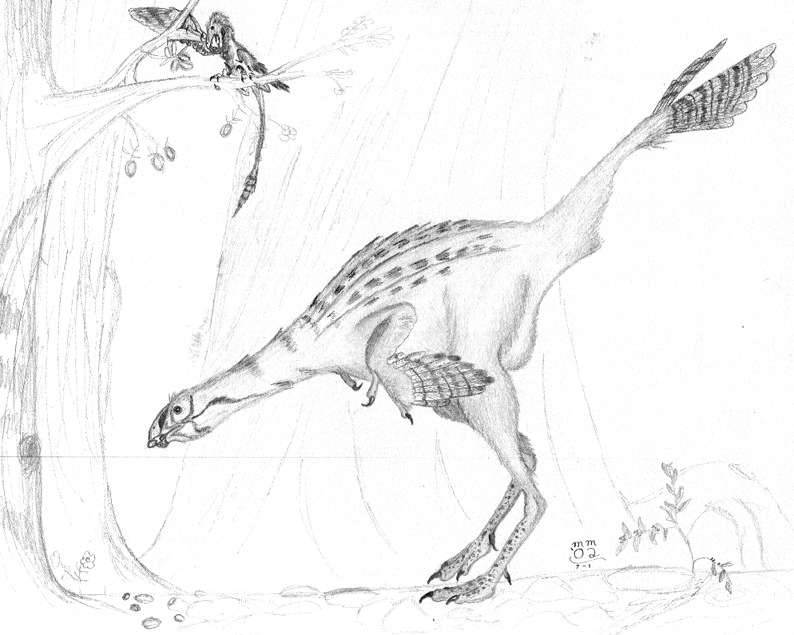
Inaccurate drawing from 1 July 2002. This attempt at drawing a caudipter is a vast improvement from the 2001 effort (see below) in terms of overall anatomy, and still holds up reasonably well. The main inaccuracy still lingering here is a restoration of the short-lived meme of the split-tail, and the still hind-wingless Microraptor zhaoianus perched above.
"Puff-Tailed Dromaeosaur" (Cryptovolans pauli) (Stem-Aves, Microraptoria):
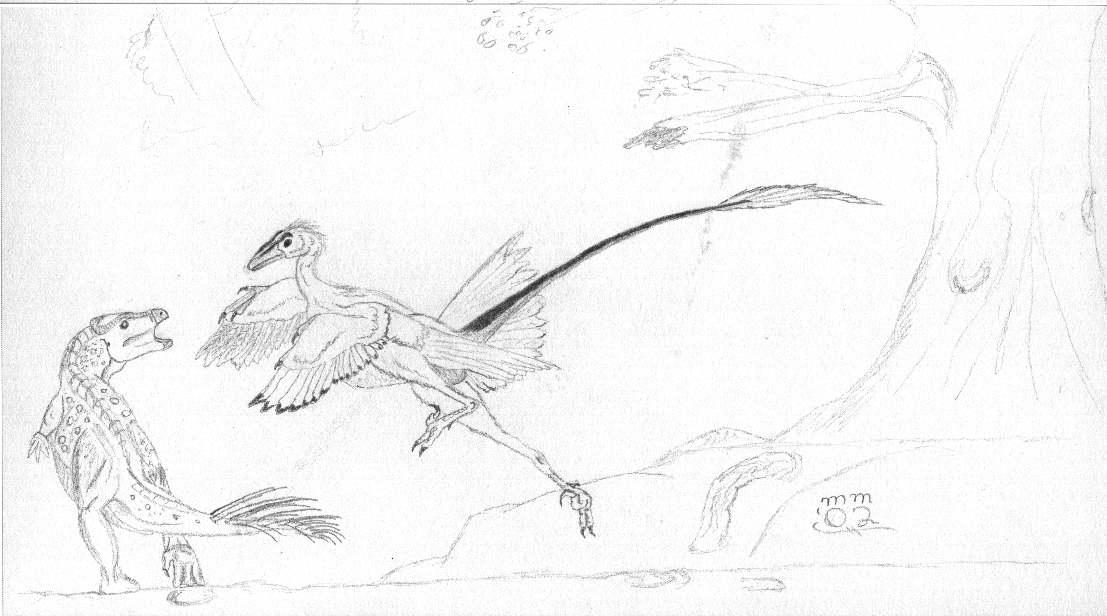
Inaccurate drawing from May 2002. In early 2002, the second feathered dromaeosaur-like dinosaur (after Sinornithosaurus) was described, but not named. It appeared to have a weird characteristic: long, vaned feathers attaching to the thigh. I speculated that these must have been for display, and may have been able to "fan" open and closed with muscle action in the thigh and pelvic region. Interestingly, this specimen also preserved a little spray of feathers near the tip of the tail, rather than all along its length as in Archaeopteryx and Sinornithosaurus. This led me to nickname the nameless species as the "puff-tailed dromaeosaur" (here shown attacking a Liaoceratops). It's hard to remember details from so long ago, but I may also take the blame for coining the term "butt fans" for those long thigh feathers. Later, these "butt fans" would be re-interpreted as long extensions of the wing feather, and then re-re-interpreted as part of a much more extensive set of hind wings. The "puff-tail dromaeosaur" was later made the holotype of Cryptovolans pauli.
Quetzalcoatlus northropi (Stem-Aves, Pterosauromorpha):
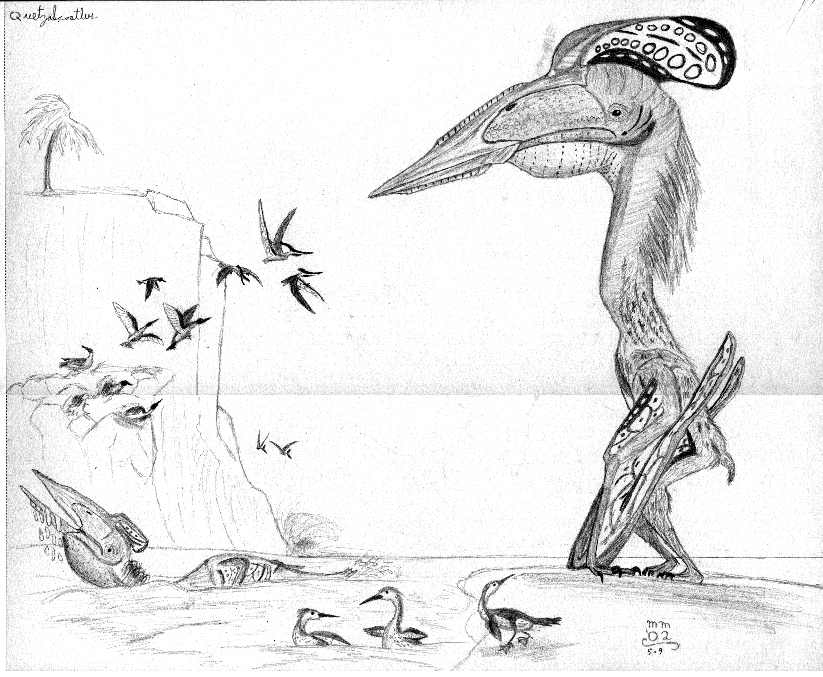
Inaccurate drawing from 9 May 2002. Looking back, this could almost be a rejected entry for seminal paleoart book All Yesterdays. Though avant-garde can be good, this was originally done earnestly as a "modern" depiction of Q.n. to counteract the old-fashioned, Wellnhofer-style azhdarchids prevalent in paleoart at the time. The main thing that led me astray here was the influence of David Peters, whose online skeletals of the time depicted azhdarchids with disproportionately huge skulls. The wings here carry my 2002 butterfly wing (see below), and was also probably one of my first illustrations with correct wing folding arrangement (earlier drawings had used the inaccurate Walking With Dinosaurs fold-up kite method). Besides the ridiculously huge noggin, Quetz should have a patagium between the tail and foot, and the wing membrane should probably anchor closer to the ankle. This scene is inaccurate in that it places Q.n. among the Western Interior Seaway fauna of the early Campanian, rather than its native Maastrichtian. It was also probably more likely to be found in inland habitats, which I knew at the time, but drew it seaside to illustrate a swimming, filter feeding lifestyle. Not sure where I picked that tidbit up, but needless to say, it's extremely implausible, though pterosaurs could probably swim quite well, and this may be one of the earlier depictions of one doing so.
Pterodactylus antiquus (Stem-Aves, Pterosauromorpha):
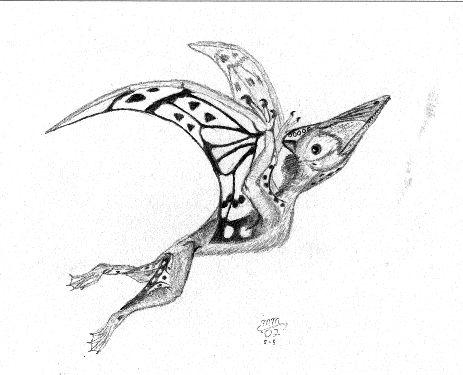
Inaccurate drawing from 5 May 2002. I went on a kick of trying to invoke butterflies in the wing patterns of my pterosaurs during 2002, resulting in animals that look like rejects from Through the Looking Glass. This illustration of a flapling Pterodactylus antiquus (based on a specimen previously referred to as Pterodactylus micronyx) was intended to reflect then-new developments in the appearance of Pterodactylus, notably the shaggy 'mane' on the neck, soft tissue crest, and webbed feet. Sadly, in addition to the garish patterning a few other details here are wrong, such as the wing membrane attaching at the torso rather than the leg, the pointy wingtips, and even orientation of the eye (it wasn't possible to rotate the eyeball much independently of the head in stem birds). If I were re-doing this today I'd also probably choose a more streamlined, aerodynamic form to the pycnofibre coat rather than conforming to the shape of the underlying musculature.
Beipiaosaurus inexpectus (Stem-Aves, Segnosauria):
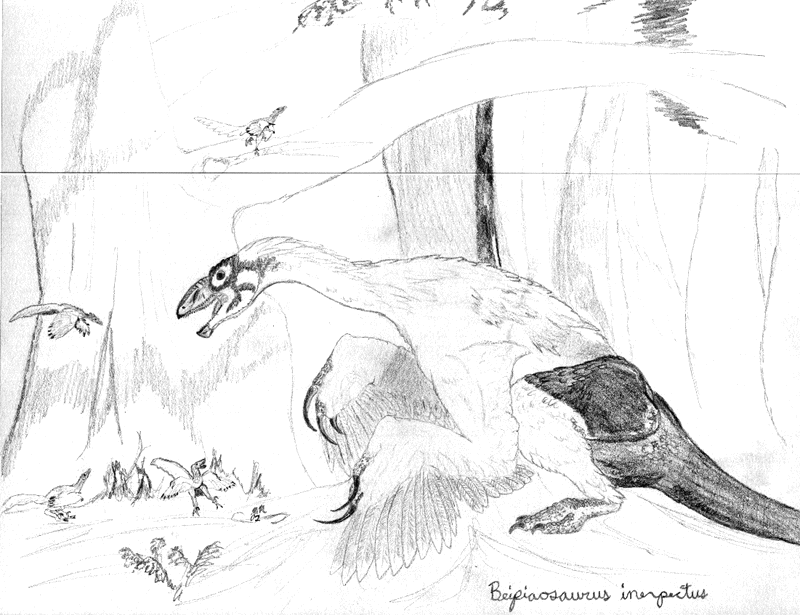
Inaccurate drawing from April 2002. Though inaccurate, I still like the layout and poses in this scene. I thought, at the time, that this was a great way to showcase the then-largest known feathered dinosaur by posing it with the then-smallest known: Microraptor zhaoianus. Here, a flock of microraptor stumble too close to a nesting beipiaosaur. This was before the most famous aspect of microraptorian biology, the huge hind wings, were known, and the tail is reconstructed after that of Archaeopteryx. Thanks to newer specimens, I now know the skull of this beipiaosaur is way off, that the neck feathers should be much longer and more voluminous (ruining that graceful curve), and that the tail should be feathered down to the tip.
Azhdarcho lancicollis (Stem-Aves, Pterosauromorpha):
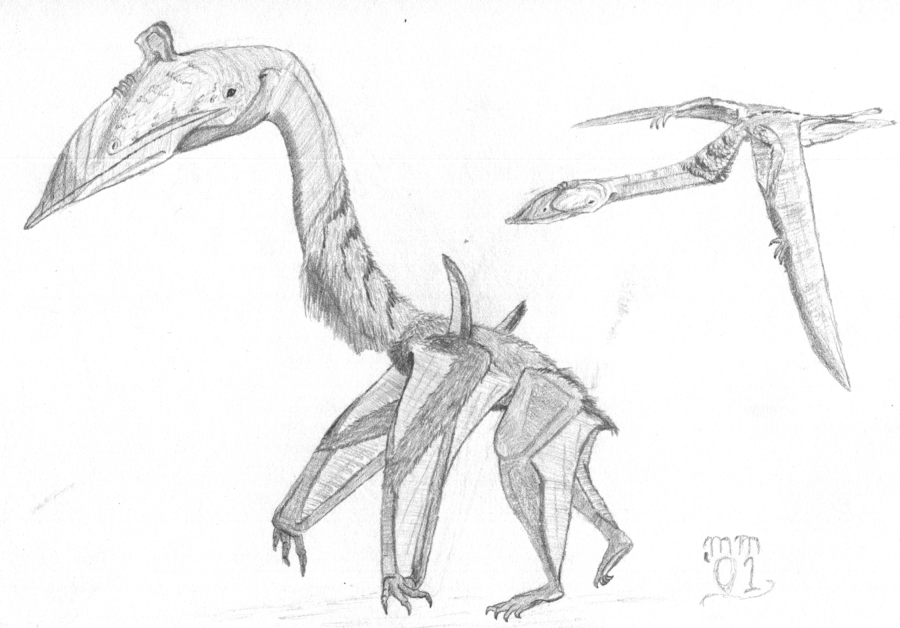
Inaccurate drawing from December 2001. A full body restoration to accompany the profile (below), this one is even weirder. Strictly following David Peters' early 2000s era skeletals yielded some kind of strange, spindly spider creature with a gigantic head and a wing membrane attached to the upper hip. The theropod-like leg musculature doesn't help. The little series of ridges near the crest somehow make this look very retro-space age.
Azhdarcho lancicollis (Stem-Aves, Pterosauromorpha):
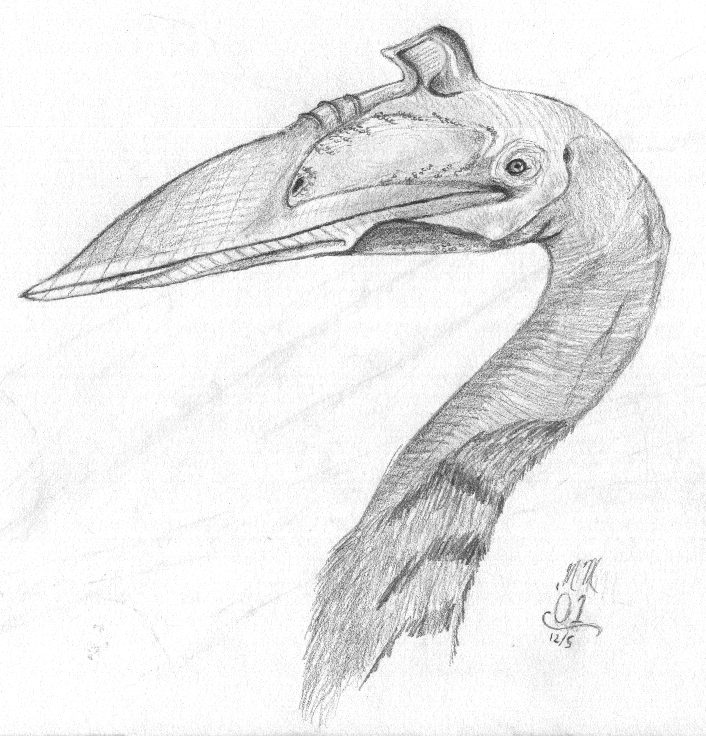
Inaccurate drawing from 5 December 2001. As the original name for my web site was azhdarcho.com, I made several attempts to draw its namesake pterosaur. The first was based on no references and was designed as basically a generic, odd-looking azhdarchid after David Peters. In the years since, some decent skull material of Azhdarcho has been described, confirming that totally speculative profiles like this are inaccurate.
Postosuchus kirkpatricki (Stem-Crocodilia, Rauisuchidae):
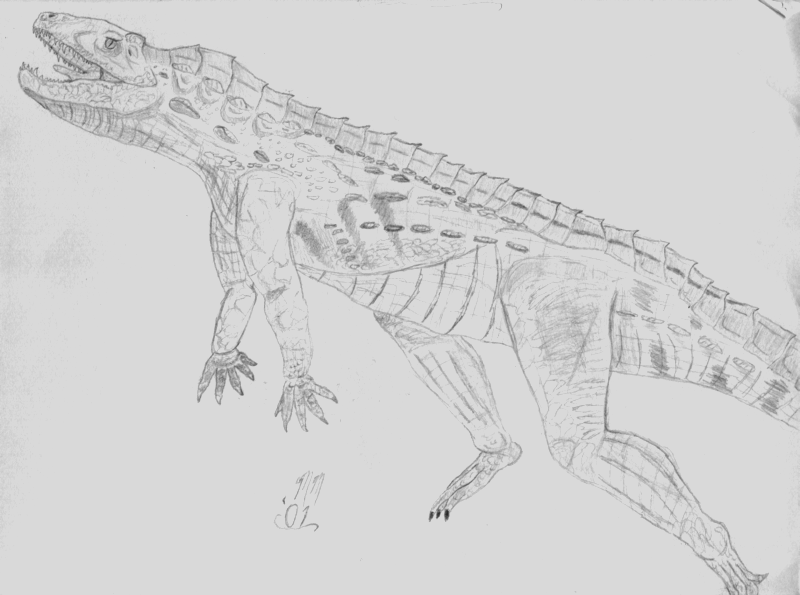
Inaccurate drawing from 2001. The celebrity stem-croc featured in Walking With Dinosaurs, I tried to do a new take on Postosuchus with limited success. There idea here was to depict it as a facultative biped, running on the hind legs when necessary but mostly living on all fours. So I chose to go with this somewhat lizard-like running stance, and regrettably very human-looking legs with weird, long toes.
Amphicoelis fragillimus (Stem-Aves, Pachypodosauria):
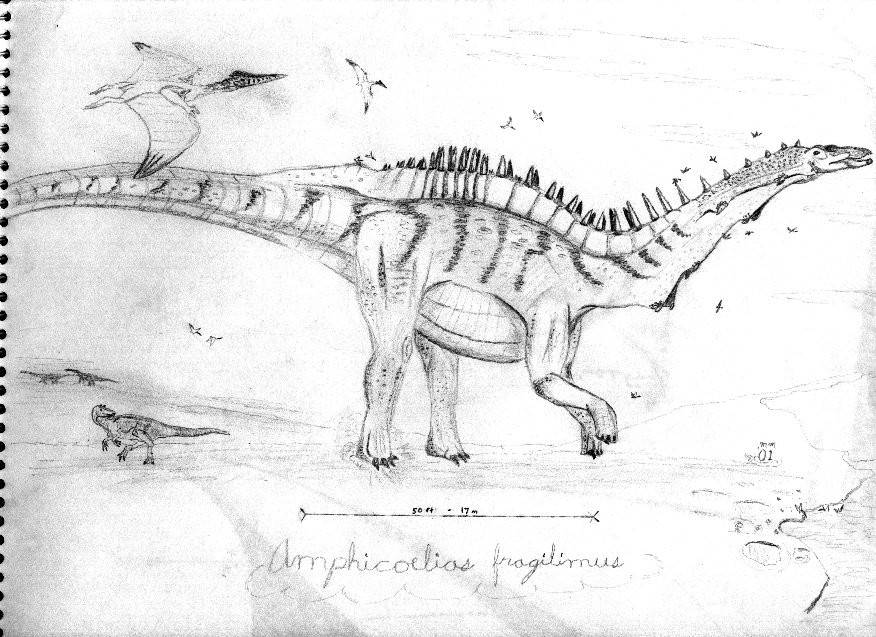
Inaccurate drawing from November 2001. First of several attempts to restore the mythical gigapod, this commits several now-cardinal sins of sauropod restoration, including too many forefoot claws, attendant flock of tiny pteorsaurs (Wyomingopteryx), and a near comical assumption that an animal this size would need to stomp its foot in order to scare away a pathetically small allosaur. Note the double dewlap.
Giraffatitan brancai (Stem-Aves, Pachypodosauria):
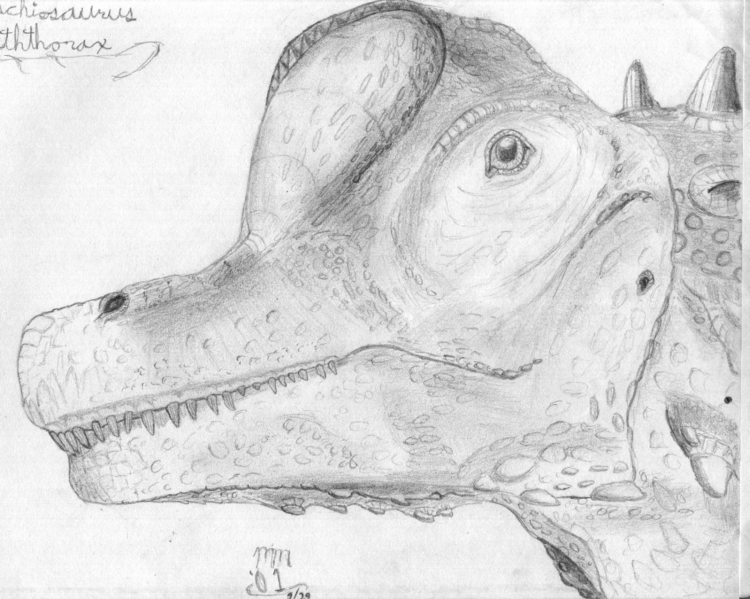
Inaccurate drawing from 29 September 2001. This giraffatitan was one of my first attempts at adding a lot of detail to a drawing, and did strive to incorporate current research, like the forward-placed nostrils. Some things that need to be fixed, tohugh, are the lack of jaw musculature and general shrink-wrapped appearance. Today, I'd probably also fill in the space between the "crest" and nostril with a large resonating chamber, rather than the weird little tube, and maybe add some lips. Note that while labeled Brachiosaurus altithorax, this is based on the skull of Brachiosaurus brancai (=Giraffatitan).
Caudipteryx zhoui (Stem-Aves, Caenagnathiformes):
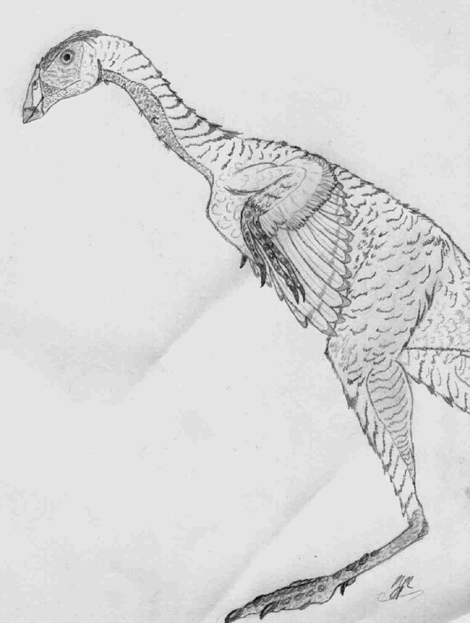
Inaccurate drawing from June 2001. This drawing, an early attempt at one of the first known feathered dinosaurs, was influential in a lot of ways. The primary inaccuracy here is the arrangement of the wing. At the time, I obviously had no idea how wings are put together or what bones in a bird correspond to those in non-avian theropods. So, like many inexperienced paleoartists, I drew the primary feathers sticking off the wrist, with a hand added on (and, strangely, over) the place of the wing. It took me a while (and several message board threads) to learn the correct arrangement.
Quetzalcoatlus northropi (Stem-Aves, Pterosauromorpha):

Inaccurate drawing from 2001. This is the drawing that got me interested in pterosaurs and led to the naming of azhdarcho.com. While working on this, I could not figure out based on any sources I had what the correct wing folding arrangement should be. It ended up looking like the situation depicted in Walking With Dinosaurs, but something didn't sit right between that and the skeletal by David Peters I was looking at. I went out to hunt down more sources and learn more about pterosaur anatomy... leading to disastrous results in my next attempt (see above).
"Arboreal Maniraptor" (Scansoriopteryx heilmanni) (Stem-Aves, Scansoriopterygidae):
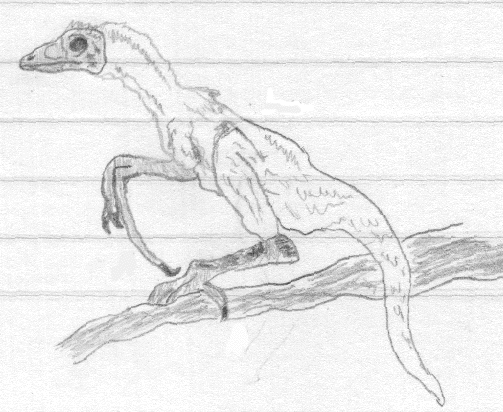
Inaccurate drawing from May 2000. Obviously more of a doodle than a serious attempt at a drawing, this represents an interesting case of a reconstruction based solely on word of mouth. Reports of an arboreal maniraptoran presented at SVP were relayed on the DML, with a brief description that it was tiny, preserved an apparently reversed hallux (not quite true), feathers, and an unusually long third digit. The specimen would later be described as Epidendrosaurus, a probable synonym of Scansoripteryx heilmanni. Note that, apparently, the knowledge about theropod hand pronation and "clappers not slappers" had not yet reached me.
